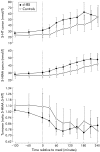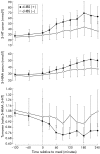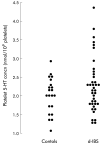Increased platelet depleted plasma 5-hydroxytryptamine concentration following meal ingestion in symptomatic female subjects with diarrhoea predominant irritable bowel syndrome
- PMID: 12692050
- PMCID: PMC1773651
- DOI: 10.1136/gut.52.5.663
Increased platelet depleted plasma 5-hydroxytryptamine concentration following meal ingestion in symptomatic female subjects with diarrhoea predominant irritable bowel syndrome
Abstract
Background: Meal ingestion is often associated with exacerbation of gastrointestinal symptoms in subjects with irritable bowel syndrome (IBS). Furthermore, recent preliminary data suggest that 5-hydroxytryptamine (5-HT) concentration in platelet poor plasma is elevated following meal ingestion in some subjects with diarrhoea predominant IBS (d-IBS) compared with healthy subjects, although it is not known whether this is related to postprandial symptomatology.
Aim: To expand on previous data by evaluating a larger number of subjects but also to assess plasma 5-hydroxyindole acetic acid (5-HIAA) concentrations, 5-HT turnover, platelet 5-HT stores, and any relationship to symptomatology.
Methods: We assessed platelet depleted plasma 5-HT and 5-HIAA concentrations for two hours (60 minute intervals) under fasting conditions, and then for a further four hours (30 minute intervals) after a standard carbohydrate meal (457 kcal), together with fasting platelet 5-HT concentrations in 39 female subjects with d-IBS (aged 19-52 years; mean age 33) and 20 healthy female volunteers (aged 20-46 years, mean age 28). IBS symptomatology, in particular abdominal pain and bloating, and urgency to defecate were assessed throughout the study
Results: When related to fasting levels, there was no statistically significant difference in postprandial plasma 5-HT concentrations between d-IBS and healthy subjects. However, when fasting levels were not taken into consideration, d-IBS subjects exhibited higher postprandial plasma 5-HT concentrations compared with healthy subjects (p=0.040). Furthermore, d-IBS subjects who exhibited postprandial symptomatology had higher levels of postprandial plasma 5-HT, whether assessed with respect to fasting baseline levels (p=0.069) or not (p=0.047), compared with d-IBS subjects who did not report postprandial symptomatology. This appeared to be associated with a concomitant increase in plasma 5-HIAA (p=0.161) but reduction in turnover (p=0.058). Lastly, d-IBS subjects had higher platelet concentrations of 5-HT than healthy subjects (p=0.009).
Conclusions: These data suggest that postprandial symptomatology may be associated with increased platelet depleted plasma 5-HT concentrations in female subjects with d-IBS. In addition, the presence of increased platelet stores of 5-HT may act as a useful marker for the diagnosis and management of d-IBS.
Figures







Comment in
-
Of actors, bolting horses, and drops in oceans!Gut. 2003 May;52(5):619-21. doi: 10.1136/gut.52.5.619. Gut. 2003. PMID: 12692041 Free PMC article. No abstract available.
-
Platelet activation in patients with irritable bowel syndrome may reflect a subclinical inflammatory response.Gut. 2003 Dec;52(12):1799-800. doi: 10.1136/gut.52.12.1799-a. Gut. 2003. PMID: 14633969 Free PMC article. No abstract available.
References
-
- Ragnarsson G, Bodemar G. Pain is temporally related to eating but not to defaecation in the irritable bowel syndrome (IBS). Patients’ description of diarrhoea, constipation and symptom variation during a prospective 6 week study. Eur J Gastroenterol Hepatol 1998;10:415–21. - PubMed
-
- Simren M, Mansson A, Langkilde AM, et al. Food-related gastrointestinal symptoms in the irritable bowel syndrome. Digestion 2001;63:108–15. - PubMed
-
- Narducci F, Bassotti G, Granata MT, et al. Colonic motility and gastric emptying in patients with irritable bowel syndrome. Dig Dis Sci 1986;31:241–6. - PubMed
-
- Sullivan MA, Cohen S, Snape WJ. Colonic myoelectrical activity in irritable bowel syndrome. N Engl J Med 1987;298:878–83. - PubMed
Publication types
MeSH terms
Substances
Grants and funding
LinkOut - more resources
Full Text Sources
Other Literature Sources
Medical
